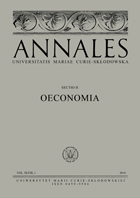Low Interest Rates and Changes in the Banking Income Structure
Low Interest Rates and Changes in the Banking Income Structure
Author(s): Sylwester KozakSubject(s): Economic policy, Financial Markets
Published by: Wydawnictwo Naukowe Uniwersytetu Marii Curie-Sklodowskiej
Keywords: interest rates; financial markets; banks;
Summary/Abstract: The relaxed monetary policy of central banks conducted after the global financial crisis has led to the establishment of zero or even negative interest rates. Based on data from the ECB and central banks of the EU Member States for the years 2008–2016, it has been noted that the long-term maintenance of ultra-low interest rates contributes to a reduction in net interest margin and interest income, particularly in smaller banks and retail banks. Banks systematically increase the share of non-interest income in the structure of income from banking activity. The largest category of such income is fees and commissions, largely related to the performance of deposit and credit activities. The second sources of non-interest income are the bank trading activities. That income is characterized by the highest volatility, which makes it a source of risk and cannot be treated as a stabilizer of banks’ income during times of economic downturn and slowing down in lending.
Journal: Annales Universitatis Mariae Curie-Skłodowska, Sectio H Oeconomia
- Issue Year: LII/2018
- Issue No: 1
- Page Range: 97-107
- Page Count: 11
- Language: English

